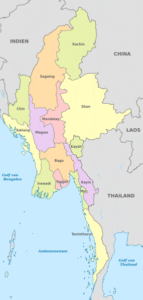by Alessandro De Pascale
Back from Chin State (Myanmar) – “We’re now using drones in most of our operations,” confirms the training centre at Camp Victoria, perhaps the largest and most extensive military facility operated by the Chin National Army (CNA), one of the largest ethnic armed groups resisting the coup junta in Burma. We are in the vast Chin State in north-west Myanmar, on the border with India. Here, too, the rebels, who for three years have opposed the military junta that seized power in a coup on 1 February 2021, use small unmanned aerial vehicles (bought or homemade) to “correct an imbalance”.

Myanmar’s coup leaders have lost control of over 50% of the Country. But the Tatmadaw, Burma’s regular army, the second largest in Southeast Asia, can count on a huge air force of fighter jets and helicopters. It uses them to terrorise the population. It bombs towns and villages, turning them into ghost towns after raids that have killed thousands of people. A well-equipped but expensive air force, requiring not only adequate training for its personnel, but also constant maintenance, spare parts and armaments to remain operational. As in all conflicts of our time, the use of cheap and versatile drones by the rebels is a game-changer in Myanmar’s war. “At first we were unable to use them,” admits Ram Kulh Cung, deputy secretary-general of the CNA. “For the first 12 months, we missed most of our targets, but now these drones are our air force”.
The unmanned aerial vehicle division of the Chin National Army was formed over a year ago. It is currently made up of young people who were flying commercial drones as a hobby before the coup three years ago. “These devices are the key to our success,” continues the CNA deputy secretary-general. “Attacks with the drones in our possession, carried out after months of planning and training, are carried out by operators who control them hidden in the forest,” Ram Kulh Cung of the Chin National Army adds. Depending on the aircraft used, whoever is remotely controlling the device in question can do so from a few hundred metres to a kilometre away from the target. “The junta soldiers fear these attacks. When they see the drones approaching, they run for cover in terror”.
The Myanmar military junta’s spokesman, Zaw Min Tun, admitted on 15 November that the Tatmadaw was suffering “heavy attacks by a significant number of armed rebels”. These were the first effects on the ground of the massive and systematic campaign still underway in Shan State in the north (bordering China, Laos and Thailand), Kayah State in the east (with Thailand) and Rakhine State in the west (Bangladesh), known as Operation 1027. It was launched in October by the Brotherhood Alliance, a coalition of three rebel groups: the Arakan Army (AA), the Myanmar National Democratic Alliance Army (MNDAA) and the Ta’ang National Liberation Army (TNLA). For example, the November drone attack on the town of Muse on the northeastern border with China, in which the coup plotters lost more than 250 supply trucks, was attributed to them. Most importantly, it confirmed the effectiveness of these small, easy-to-find unmanned aerial vehicles in the hands of the rebels.
Depending on the closest neighbouring country, rebel groups buy these drones on the open commercial market in China or in India (countries whose companies are among the top 20 commercial drone manufacturers). Or they build them themselves. Soldiers of the Karenni Nationalities Defence Force (KNDF), a rebel formation in Kayah State on the border with Thailand, make them “at home”: the drone frame, often a fixed-wing drone (and therefore very similar to a small plane), is made using 3D printers and then covered with fibreglass. The rest of the necessary components are bought on the market (including online and from Western countries). To build them, they take inspiration from existing unmanned aerial vehicles or from the many projects on the Deep Web (sites that are not accessible via search engines) or the Dark Web (hidden sites that can only be accessed by knowing the address and using special browsers).
Building your own drone costs “around $5,000”. Slightly less than it takes to buy an unmanned aircraft with six propellers, capable of carrying up to six kilos, on the market. Drones similar to those used by some well-known e-commerce or delivery companies in Countries or cities where this mode has been authorised by the relevant authorities. The fundamental difference, in the case of the Burmese rebels, is that what is suspended from the drone is not a parcel but a device containing several kilos of explosives to be dropped on the target. There are also many freely available manuals on the Internet on how to arm an ordinary drone. Some of them are signed ISIL: the Islamic State of Iraq and the Levant, the international paramilitary and Islamic fundamentalist terrorist organisation founded in 2013 by Abu Musab al-Zarqawi and Abu Bakr al-Baghdadi.
Cover photo: A village bombed by the military junta in Chin State, Myanmar © Alessandro De Pascale
In the text: Map of the administrative division of Myanmar
























